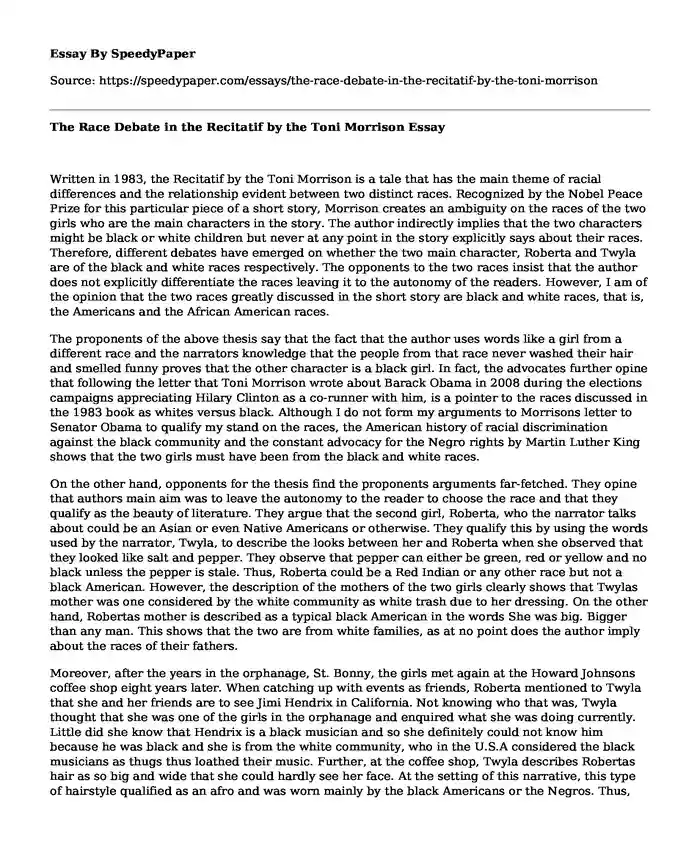
| Type of paper: | Essay |
| Categories: | Race Literature |
| Pages: | 3 |
| Wordcount: | 780 words |
Written in 1983, the Recitatif by the Toni Morrison is a tale that has the main theme of racial differences and the relationship evident between two distinct races. Recognized by the Nobel Peace Prize for this particular piece of a short story, Morrison creates an ambiguity on the races of the two girls who are the main characters in the story. The author indirectly implies that the two characters might be black or white children but never at any point in the story explicitly says about their races. Therefore, different debates have emerged on whether the two main character, Roberta and Twyla are of the black and white races respectively. The opponents to the two races insist that the author does not explicitly differentiate the races leaving it to the autonomy of the readers. However, I am of the opinion that the two races greatly discussed in the short story are black and white races, that is, the Americans and the African American races.
The proponents of the above thesis say that the fact that the author uses words like a girl from a different race and the narrators knowledge that the people from that race never washed their hair and smelled funny proves that the other character is a black girl. In fact, the advocates further opine that following the letter that Toni Morrison wrote about Barack Obama in 2008 during the elections campaigns appreciating Hilary Clinton as a co-runner with him, is a pointer to the races discussed in the 1983 book as whites versus black. Although I do not form my arguments to Morrisons letter to Senator Obama to qualify my stand on the races, the American history of racial discrimination against the black community and the constant advocacy for the Negro rights by Martin Luther King shows that the two girls must have been from the black and white races.
On the other hand, opponents for the thesis find the proponents arguments far-fetched. They opine that authors main aim was to leave the autonomy to the reader to choose the race and that they qualify as the beauty of literature. They argue that the second girl, Roberta, who the narrator talks about could be an Asian or even Native Americans or otherwise. They qualify this by using the words used by the narrator, Twyla, to describe the looks between her and Roberta when she observed that they looked like salt and pepper. They observe that pepper can either be green, red or yellow and no black unless the pepper is stale. Thus, Roberta could be a Red Indian or any other race but not a black American. However, the description of the mothers of the two girls clearly shows that Twylas mother was one considered by the white community as white trash due to her dressing. On the other hand, Robertas mother is described as a typical black American in the words She was big. Bigger than any man. This shows that the two are from white families, as at no point does the author imply about the races of their fathers.
Moreover, after the years in the orphanage, St. Bonny, the girls met again at the Howard Johnsons coffee shop eight years later. When catching up with events as friends, Roberta mentioned to Twyla that she and her friends are to see Jimi Hendrix in California. Not knowing who that was, Twyla thought that she was one of the girls in the orphanage and enquired what she was doing currently. Little did she know that Hendrix is a black musician and so she definitely could not know him because he was black and she is from the white community, who in the U.S.A considered the black musicians as thugs thus loathed their music. Further, at the coffee shop, Twyla describes Robertas hair as so big and wide that she could hardly see her face. At the setting of this narrative, this type of hairstyle qualified as an afro and was worn mainly by the black Americans or the Negros. Thus, qualifies the two girls as from the white and black races.
In conclusion, although there is no express indication of the races of the two main characters, Twyla and Roberta, the indirect insinuations and the use of phrases by the author shows clearly point out the races as being white and black. Further, the use of abusive words by the elders of one community, Twylas mother, showed the discrimination that the black American experienced thus pointing out the different races. Moreover, the ignorance of the activities carried out by the African-American community and the description of the mothers of the two girls qualifies the two races.
Cite this page
The Race Debate in the Recitatif by the Toni Morrison. (2019, Jun 07). Retrieved from https://speedypaper.net/essays/the-race-debate-in-the-recitatif-by-the-toni-morrison
Request Removal
If you are the original author of this essay and no longer wish to have it published on the SpeedyPaper website, please click below to request its removal:
- Human Development Research Paper and Many More Free Essays at SpeedyPaper
- Management of Criminal Justice, Essay Example
- Is the American Jury System Still a Good Idea? Law Essay Example
- Angela's Story: A Case Study on the Reproductive System. Essay Example
- Essay Sample - Prior Research on Conceptualizing Culture: Possibilities for Political Science
- Personal Reflection on Language. Free Essay Example
- Essay Example on Revamping Healthcare in Tehachapi Valley: Introducing Virtual Caregiving
Popular categories




